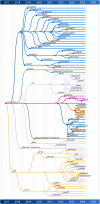A review of large language models and autonomous agents in chemistry
- PMID: 39829984
- PMCID: PMC11739813
- DOI: 10.1039/d4sc03921a
A review of large language models and autonomous agents in chemistry
Abstract
Large language models (LLMs) have emerged as powerful tools in chemistry, significantly impacting molecule design, property prediction, and synthesis optimization. This review highlights LLM capabilities in these domains and their potential to accelerate scientific discovery through automation. We also review LLM-based autonomous agents: LLMs with a broader set of tools to interact with their surrounding environment. These agents perform diverse tasks such as paper scraping, interfacing with automated laboratories, and synthesis planning. As agents are an emerging topic, we extend the scope of our review of agents beyond chemistry and discuss across any scientific domains. This review covers the recent history, current capabilities, and design of LLMs and autonomous agents, addressing specific challenges, opportunities, and future directions in chemistry. Key challenges include data quality and integration, model interpretability, and the need for standard benchmarks, while future directions point towards more sophisticated multi-modal agents and enhanced collaboration between agents and experimental methods. Due to the quick pace of this field, a repository has been built to keep track of the latest studies: https://github.com/ur-whitelab/LLMs-in-science.
This journal is © The Royal Society of Chemistry.
Conflict of interest statement
The authors have no conflicts to declare.
Figures






References
-
- Willett P. Chemoinformatics: a history. Wiley Interdiscip. Rev.: Comput. Mol. Sci. 2011;1(1):46–56.
-
- Griffen E. J. Dossetter A. G. Leach A. G. Chemists: AI Is Here; Unite To Get the Benefits. J. Med. Chem. 2020;63(16):8695–8704. doi: 10.1021/acs.jmedchem.0c00163. https://dx.doi.org/10.1021/acs.jmedchem.0c00163 - DOI - DOI - PubMed
-
- Baum Z. J. Xiang Yu. Ayala P. Y. Zhao Y. Watkins S. P. Zhou Q. Artificial Intelligence in Chemistry: Current Trends and Future Directions. J. Chem. Inf. Model. 2021;61(7):3197–3212. doi: 10.1021/acs.jcim.1c00619. https://dx.doi.org/10.1021/acs.jcim.1c00619 - DOI - DOI - PubMed
-
- Ayres L. B. Gomez F. J. V. Linton J. R. Silva M. F. Garcia C. D. Taking the leap between analytical chemistry and artificial intelligence: A tutorial review. Anal. Chim. Acta. 2021;1161:338403. doi: 10.1016/j.aca.2021.338403. https://dx.doi.org/10.1016/j.aca.2021.338403 - DOI - DOI - PubMed
-
- Yang X. Wang Y. Byrne R. Schneider G. Yang S. Concepts of Artificial Intelligence for Computer-Assisted Drug Discovery. Chem. Rev. 2019;119(18):10520–10594. doi: 10.1021/acs.chemrev.8b00728. https://dx.doi.org/10.1021/acs.chemrev.8b00728 - DOI - DOI - PubMed
Publication types
LinkOut - more resources
Full Text Sources
Research Materials

